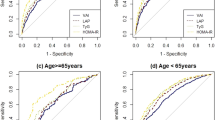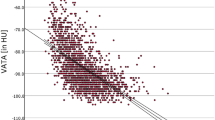Abstract
Objective:
To determine whether a series of new computed tomography (CT)-derived indices are better diagnostic criteria than the classical CT-derived measurements. A second objective is to propose specific or sensitive threshold values of the most accurate criteria for the occurrence of metabolic disturbances.
Subjects/Methods:
Anthropometric measurements and CT scans were performed in 74 obese subjects. Fat thicknesses, diameters, diagonals and areas were determined. Plasma lipids, insulin, glucose and fat cell size were analyzed. A multivariate regression analysis was performed to determine the most accurate predictor index for metabolic alterations explaining the highest percentage of variance.
Results:
All the new indices were highly correlated with body mass index, percentage of fat and fat cell size. Subcutaneous thicknesses were greater in women, while internal-coronal and sagittal diameters, visceral adipose tissue (VAT) and internal circumference area were greater in men (P<0.001). Those observations were reinforced by the adipocyte size in both fat depots. Subcutaneous parameters showed the strongest correlation with metabolic alterations, being positively associated with metabolic risk in women and negatively in men. Multivariate regression analysis showed that the best predictor index was the superficial subcutaneous adipose tissue (SSAT) and its relation to visceral area (SSAT/VAT), explaining 42% of total variance for high-density lipoprotein-cholesterol in men and 26% for homeostasis model assessment in women. After receiver operating characteristic-curves analysis, three threshold values for both sexes were proposed to select the most appropriate depending on the clinical situation.
Conclusion:
For the first time, we have described SSAT and the SSAT/VAT ratio as important indices in obesity-related disturbances.
This is a preview of subscription content, access via your institution
Access options
Subscribe to this journal
Receive 12 print issues and online access
$259.00 per year
only $21.58 per issue
Buy this article
- Purchase on Springer Link
- Instant access to full article PDF
Prices may be subject to local taxes which are calculated during checkout

Similar content being viewed by others
References
Abate N, Garg A, Peshock RM, Stray-Gundersen J, Adams-Huet B, Grundy SM (1996). Relationship of generalized and regional adiposity to insulin sensitivity in men with NIDDM. Diabetes 45, 1684–1693.
Abate N, Garg A, Peshock RM, Stray-Gundersen J, Grundy SM (1995). Relationships of generalized and regional adiposity to insulin sensitivity in men. J Clin Invest 96, 88–98.
Alexander HG, Dugdale AE (1992). Fascial planes within subcutaneous fat in humans. Eur J Clin Nutr 46, 903–906.
Ascaso JF, Romero P, Real JT, Priego A, Valdecabres C, Carmena R (2001). Insulin resistance quantification by fasting insulin plasma values and HOMA index in a non-diabetic population. Med Clin (Barc) 117, 530–533.
Bjorntorp P (1990). ‘Portal’ adipose tissue as a generator of risk factors for cardiovascular disease and diabetes. Arteriosclerosis 10, 493–496.
Bjorntorp P, Sjostrom L (1971). Number and size of adipose tissue fat cells in relation to metabolism in human obesity. Metabolism 20, 703–713.
Chan JM, Rimm EB, Colditz GA, Stampfer MJ, Willett WC (1994). Obesity, fat distribution, and weight gain as risk factors for clinical diabetes in men. Diabetes Care 17, 961–969.
Conway JM, Yanovski SZ, Avila NA, Hubbard VS (1995). Visceral adipose tissue differences in black and white women. Am J Clin Nutr 61, 765–771.
Despres JP, Moorjani S, Ferland M, Tremblay A, Lupien PJ, Nadeau A et al. (1989). Adipose tissue distribution and plasma lipoprotein levels in obese women. Importance of intra-abdominal fat. Arteriosclerosis 9, 203–210.
Enevoldsen LH, Simonsen L, Stallknecht B, Galbo H, Bulow J (2001). In vivo human lipolytic activity in preperitoneal and subdivisions of subcutaneous abdominal adipose tissue. Am J Physiol Endocrinol Metab 281, E1110–E1114.
Frayn KN, Samra JS, Summers LK (1997). Visceral fat in relation to health: is it a major culprit or simply an innocent bystander? Int J Obes Relat Metab Disord 21, 1191–1192.
Fujioka S, Matsuzawa Y, Tokunaga K, Tarui S (1987). Contribution of intra-abdominal fat accumulation to the impairment of glucose and lipid metabolism in human obesity. Metabolism 36, 54–59.
Garaulet M, Hernandez-Morante JJ, Tebar FJ, Zamora S, Canteras M (2006). Two-dimensional predictive equation to classify visceral obesity in clinical practice. Obesity (Silver Spring) 14, 1181–1191.
Johnson D, Cormack GC, Abrahams PH, Dixon AK (1996). Computed tomographic observations on subcutaneous fat: implications for liposuction. Plast Reconstr Surg 97, 387–396.
Kelley DE, Thaete FL, Troost F, Huwe T, Goodpaster BH (2000). Subdivisions of subcutaneous abdominal adipose tissue and insulin resistance. Am J Physiol Endocrinol Metab 278, E941–E948.
Kubota N, Terauchi Y, Miki H, Tamemoto H, Yamauchi T, Komeda K et al. (1999). PPAR gamma mediates high-fat diet-induced adipocyte hypertrophy and insulin resistance. Mol Cell 4, 597–609.
Lemieux S, Prud'homme D, Bouchard C, Tremblay A, Despres JP (1993). Sex differences in the relation of visceral adipose tissue accumulation to total body fatness. Am J Clin Nutr 58, 463–467.
Lemieux S, Prud'homme D, Bouchard C, Tremblay A, Despres JP (1996). A single threshold value of waist girth identifies normal-weight and overweight subjects with excess visceral adipose tissue. Am J Clin Nutr 64, 685–693.
Lillioja S, Mott DM, Spraul M, Ferraro R, Foley JE, Ravussin E et al. (1993). Insulin resistance and insulin secretory dysfunction as precursors of non-insulin-dependent diabetes mellitus. Prospective studies of Pima Indians. N Engl J Med 329, 1988–1992.
Lovejoy JC, Smith SR, Rood JC (2001). Comparison of regional fat distribution and health risk factors in middle-aged white and African American women: The Healthy Transitions Study. Obes Res 9, 10–16.
Markman B, Barton FE (1987). Anatomy of the subcutaneous tissue of the trunk and lower extremity. Plast Reconstr Surg 80, 248–254.
Misra A, Garg A, Abate N, Peshock RM, Stray-Gundersen J, Grundy SM (1997). Relationship of anterior and posterior subcutaneous abdominal fat to insulin sensitivity in nondiabetic men. Obes Res 5, 93–99.
Ohlson LO, Larsson B, Svardsudd K, Welin L, Eriksson H, Wilhelmsen L et al. (1985). The influence of body fat distribution on the incidence of diabetes mellitus. 13.5 years of follow-up of the participants in the study of men born in 1913. Diabetes 34, 1055–1058.
Okuno A, Tamemoto H, Tobe K, Ueki K, Mori Y, Iwamoto K et al. (1998). Troglitazone increases the number of small adipocytes without the change of white adipose tissue mass in obese Zucker rats. J Clin Invest 101, 1354–1361.
Pouliot MC, Despres JP, Nadeau A, Moorjani S, Prud’Homme D, Lupien PJ et al. (1992). Visceral obesity in men. Associations with glucose tolerance, plasma insulin, and lipoprotein levels. Diabetes 41, 826–834.
Salas-Salvado J, Rubio MA, Barbany M, Moreno B (2007). Grupo Colaborativo de la SEEDO. SEEDO 2007 Consenso para la evaluación del sobrepeso y la obesidad y el establecimiento de criterios de intervención terapéutica. Med Clin (Barc) 128, 184–196.
Seidell JC, Bouchard C (1997). Visceral fat in relation to health: is it a major culprit or simply an innocent bystander? Int J Obes Relat Metab Disord 21, 626–631.
Siri WE (1961). Body composition from fluid spaces and density: analysis of methods. In: Brozek J, Henschel A (eds). Techniques for Measuring Body Composition. National Academy of Sciences: Washington, DC. pp 223–244.
Sjostrom L (1991). A computer-tomography based multicompartment body composition technique and anthropometric predictions of lean body mass, total and subcutaneous adipose tissue. Int J Obes 15 (Suppl 2), 19–30.
Sjöström L, Björntorp P, Vrána J (1971). Microscopic fat cell size measurements on frozen-cut adipose tissue in comparison with automatic determinations of osmium-fixed fat cells. J Lipid Res 12, 521–530.
Smith SR, Lovejoy JC, Greenway F, Ryan D, deJonge L, de la Bretonne J et al. (2001). Contributions of total body fat, abdominal subcutaneous adipose tissue compartments, and visceral adipose tissue to the metabolic complications of obesity. Metabolism 50, 425–435.
Tarui S, Tokunaga K, Fujioka S, Matsuzawa Y (1991). Visceral fat obesity: anthropological and pathophysiological aspects. Int J Obes 15 (Suppl 2), 1–8.
Zimmet P, Magliano D, Matsuzwa Y, Alberti G, Shaw J (2005). The metabolic syndrome: a global public health problem and a new definition. J Atheroscl Thromb 12, 295–300.
Acknowledgements
This study was supported by the Séneca Foundation from the Government of Murcia (Project 02934/PI/05). We thank the Pharmacist College of Murcia for the contribution to the financial support.
Author information
Authors and Affiliations
Corresponding author
Additional information
Contributors: CP contributed to the data acquisition, analysis and to the manuscript writing, JJHM was involved in the study design, partially in the analysis and in the manuscript writing, MC contributed highly to the statistical analysis, SZ was involved in the study concept and contributed to the interpretation of the results and MG did the study design, had the idea for the study, contributed to the data analysis and wrote the manuscript.
Appendices
Appendix 1a
Appendix 1b
Appendix 1c
Appendix 1d
Appendix 2a
Appendix 2b
Rights and permissions
About this article
Cite this article
Piernas, C., Hernández-Morante, J., Canteras, M. et al. New computed tomography-derived indices to predict cardiovascular and insulin-resistance risks in overweight/obese patients. Eur J Clin Nutr 63, 887–897 (2009). https://doi.org/10.1038/ejcn.2008.47
Received:
Revised:
Accepted:
Published:
Issue Date:
DOI: https://doi.org/10.1038/ejcn.2008.47



